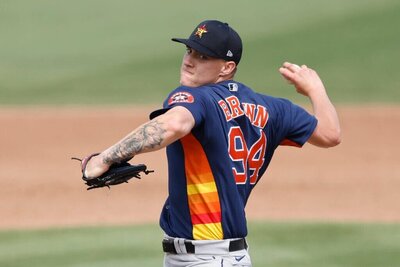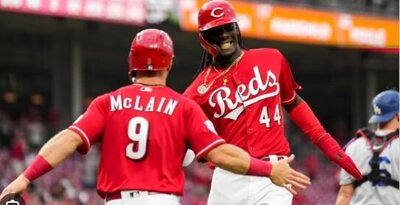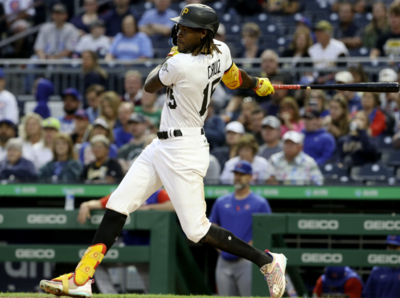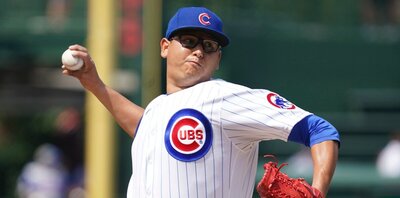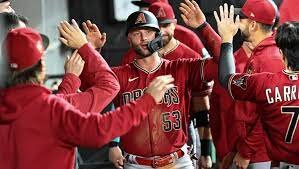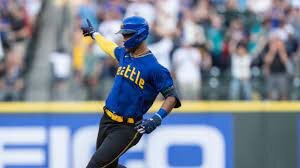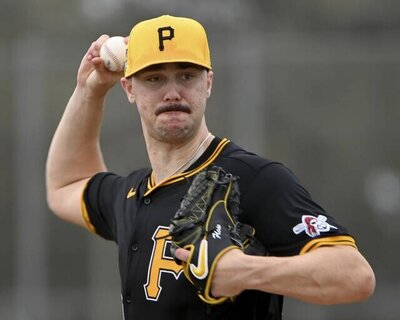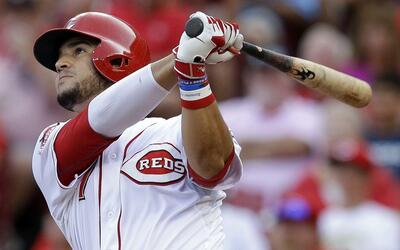NL First Pitch: There were a bunch of "aces" scheduled to throw on Wednesday, but a few of them turned out to be jokers as Tim Lincecum and Josh Johnson both had outings that could arguably go down as the worst of their careers. Both Johnson and Lincecum have started slow to the season and within the notes we'll examine what the slow start means for fantasy owners. Ryan Dempster and Johan Santana continued their strong starts to the fantasy season but digging in deeper I'll reveal some reasons I may be inclined to sell high on each of them if an opportunity presented itself. Stephen Strasburg got back to his dominant ways with 9 K's in 6 innings, but I'd like to see a higher swinging strike rate accompany the strong performance. The Padres rallied late behind a Chris Denorfia 2-run HR to hand the Diamondbacks their first loss of the season. Corey Luebke struggled with his command in the outing but kept the damage to a minimum. Huston Street picked up his first save of the season. Roy Halladay was his usual dominant self, doing it the "democratic way" as Crash Davis would say with more ground balls than strikeouts. The Rockies offense busted out of a big slump pounding out 17 runs with everyone getting into the action. Buster Posey and Brandon Belt were both absent from the starting lineup. Posey is dealing with shingles while Belt is dealing with a manager that is giving Belt owners the shingles. The Braves made it two in a row behind Jason Heyward's big performance and Craig Kimbrel's 2nd save. Mike Stanton reported lingering issues with his knee, while Drew Storen underwent a minor elbow surgery that thankfully (for the time being) wasn't Tommy John.
Ryan Dempster (SP - CHC): Dempster made it 2-for-2 in quality starts with 6 2/3 solid innings against a depleted Brewers lineup. Without Corey Hart and Ryan Braun, Dempster limited the Brewers to 2 ER's on 5 hits and 3 BB's over 6 2/3 innings. Dempster struck out 5 while generating 10 swinging strikes on 107 pitches (9.4%). While the results looked solid on the surface, the underlying indicators in this outing were weak. Dempster gave up a bunch of line drives in the outing (33%) but benefited from a .222 BABIP and 90.9% LOB%. Even more concerning for me is this was the 2nd straight start in which Dempster's average fastball velocity was 87-88 mph, 2 mph down from his average fastball velocity last season. Through two starts Dempster's results have been quite strong, but I wonder if the velocity dip will eventually catch up to him. He's had the benefit of the wind blowing strongly in during his first two outings and yesterday faced a pretty watered down Brewers lineup. He certainly deserved better than the 4.80 ERA he finished with last season, but I'm still skeptical there's not some legitimate skill deterioration that will prevent him from jumping all the way back to the high 3's ERA, low 1.30's WHIP, high 8's K/9 starter we've become accustomed to. I think he gets most of the way there (thinking 4.10, 1.33, 8.1 K/9), but will see his W total limited by the poor offense/bullpen around him. Given Dempster is a guy whose peripherals suggested a big bounceback and his early season performance has supported that, I might take the opportunity to sell a little high on Dempster if I could. The 2 mph drop in velocity should eventually trickle into the performance and brings about a bit more risk with Dempster than the two strong starts to begin the season suggest.
Aramis Ramirez (3B - MIL): For only having 2 hits in his first 22 AB's, Aramis Ramirez has actually put together modest counting totals (3 Runs, 5 RBI's, 1 SB). Ramirez took another 0-4 on Wednesday and added two strikeouts to the elevated early season totals (7 K's in 22 AB's). Ramirez is traditionally a slow starter (career .258 avg, .785 OPS in April/March) so optimists will write off the small sample size, but I see some continued trends from last season that have me concerned. Ramirez's chase rate spiked to a career high 37% and his swing % also rose to a career high 56%. At 33 (turning 34 in June), it wouldn't be a surprise to see Ramirez have lost some bat speed and thus need to start the bat earlier and "cheat" a little bit more - resulting in higher swing % and a higher chase rate. Early on in 2012, Ramirez's chase rate has stayed around this elevated level (39%) as has his swing strike % (54%). All the small sample size caveats apply, but early on Ramirez is showing some of the same signs of skill deterioration he first showed last season. Ramirez was still able to post a .308-80-26-93 line last year but was helped along by a career high LD Rate. Ramirez has shown he can still perform at an elite level even with some deterioration in bat speed and plate discipline, but with modest skill deterioration comes some slightly elevated levels of risk.
Josh Johnson (SP - MIA): Johnson turned in perhaps the worst start of his professional career. Johnson allowed 6 ER's on 11 hits in just 3 2/3 innings of work against a Phillies offense that had scored just 8 runs in their first four games. When I saw the line the first thing I looked into was Johnson's velocity which at times in his career has been a predictor of arm issues. Johnson's average fb velocity on Wednesday night was 92.6 mph, in line with his first start, which is 1 mph below last season and 2-3 mph below his peak years. The pitch f/x data was even more revealing when you look at Johnson's swinging strike rates. Johnson generated just ONE swing and miss all night on 80 pitches. In Johnson's 1st outing of the season he posted just a 6.6% swinging strike rate which is 3 percentage points below his career average. With the velocity down a touch and the swinging strike rate WAY down, it's safe to say Josh Johnson isn't the same pitcher. I've been one of the most vocal opponents of Josh Johnson on our site and these issues have only strengthened those concerns. I'd be very selective when using him until we see improved velocity and better swinging strike rates.
Tim Lincecum (SP - SF): When pitchers have their peripherals trending in the wrong direction even if they're still elite, I tend to shy away. Such has been the case the last two years with Tim Lincecum who has seen his velocity, his K Rates, and his BB Rates all go in the wrong direction. He's still been great, posting xFIPs in the low 3's and high 2's during the span, but these are red flags I just avoid where I can. Lincecum's first outing came with some very strong peripherals (62% GB Rate, 11.8 K/9, 1.7 BB/9), but also came with some warning flags. Lincecum's avg fastball velocity was just 90 mph, 2 mph down from last season, and he didn't throw a single slider - which reminded his owners of a comment made in spring training about protecting his elbow this year. Start #2 didn't fare much better. While Lincecum reintroduced his slider (throwing it 21 times out of 76 pitches), his average FB velocity was once against just 90 mph and he allowed 8 hits, 2 BB's and 6 ER's in just 2 1/3 innings of work. The good news for Lincecum owners is that the swinging strike rate remained solid (10 whiffs in 76 pitches - 13.1%) and he was able to generate swings and misses on four of his five pitches. Command appears to have been an issue as Lincecum surrendered a 41% LD Rate during the outing, suggesting he was simply leaving too many balls over the plate. His overall strike % (63%) was in line with his career numbers and the strong swinging strike rate leave me to believe much of this is correctable. Ultimately I think we're dealing with a situation where Lincecum's drop in velocity is making him more susceptible to being hit hard when his command isn't there. I don't think this is something to panic about, but perhaps something to slightly adjust our expectations going forward. With the velocity continuing to slide I'm thinking the peripherals continue their modest slide along with it. If he was at 9.12 K/9, 3.57 BB/9, 2.74 ERA last season maybe we see something like 8.9 K/9, 3.7 BB/9, and 3.25 ERA this year. I still think Timmy will be fine, perhaps more of a high-end #2 than an ace, but the drop in velocity (if sustained) will likely leak over into the production.
Chris B. Young (OF - ARZ): It's kind of flown under the radar but Chris B. Young had a monster spring (.400/.494/.738) and has carried it over into the regular season (.333/.429/.778). Young is making a lot more contact early on (90% this yr, career 76.7%) and while it's hard to imagine Young posting anything close to that, the early sample is quite appealing. Young's only drawback as a fantasy option in his career has been an inability to make consistent contact. If he's made ANY strides in this area at all, Young could be in for a big season. He's cut down the K's mildly in recent years while showing spurts of improved power and BB rates. Continuing a trend from spring training (15% K Rate) with improved contact and production all around, I'm inclined to believe in Young breaking out in his age 28 season. I'd be buying high on Young.
Follow us on Twitter all year: @Fantistics and @drewdinkmeyer

